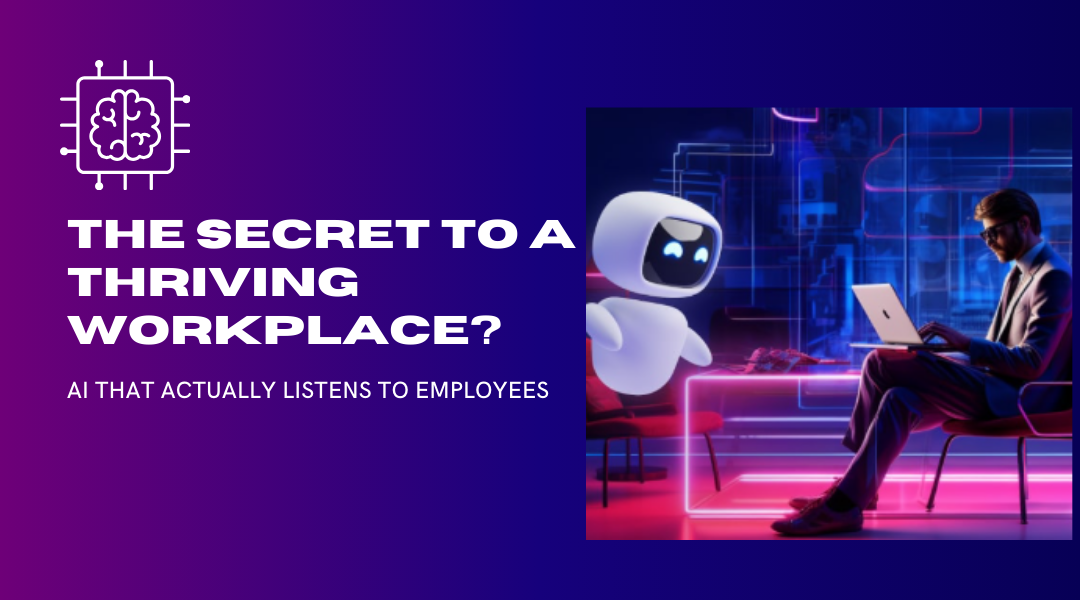The Engagement Problem Nobody Talks About
We’ve all seen the cycle: HR sends out the annual engagement survey, gets a lukewarm 30% response rate, and then… nothing changes. Meanwhile, top performers quietly update their LinkedIn profiles, and managers scratch their heads wondering why morale feels off.
Traditional engagement tools are broken. They’re slow, superficial, and often miss what’s really happening beneath the surface. But what if you could:
- Hear what employees aren’t saying in meetings?
- Predict who might quit before they even know it themselves?
- Spot burnout before it tanks your team’s productivity?
That’s where AI comes in—not as some futuristic buzzword, but as a practical tool that finally gives HR and leadership the insights they’ve been missing.
1. Reading Between the Lines: AI That Understands How Teams Really Feel
Employees rarely say exactly what they think in all-hands meetings or formal surveys. But in Slack threads, email phrasing, or even Glassdoor reviews? That’s where the truth comes out.
How it works in practice:
- An AI tool scans internal communications (anonymously) for subtle language cues—like increased use of words like “overwhelmed” or “frustrated” in a particular team’s chats.
- Instead of waiting for exit interviews, HR gets a real-time heat map of morale across departments.
Real-world example:
A mid-sized SaaS company noticed a spike in negative sentiment in engineering team chats. Turns out, unrealistic sprint deadlines were burning people out. Leadership adjusted timelines before resignations started piling up.
Why this matters:
- Catches problems early: No more “I had no idea they were unhappy” surprises.
- Goes beyond surveys: People are more honest in casual communication than in formal feedback forms.
2. The Early Warning System for Retention
Most companies only realize someone’s disengaged when they resign. By then, it’s too late. AI spots the red flags before it gets to that point.
What to watch for:
- A top sales rep who’s suddenly logging in later
- A manager whose 1:1 meeting frequency drops
- An employee who stops participating in non-mandatory events
Real-world example:
A consulting firm’s AI model flagged an otherwise high-performing manager whose team’s feedback scores had dipped for three straight months. HR discovered they’d been handed an unrealistic client load—and fixed it before their best people left.
Why this matters:
- Saves top talent: 70% of turnover is preventable if caught early.
- Cheaper than hiring: Replacing an employee costs 6-9 months of their salary on average.
3. The End of Guesswork in DEI
Every company claims to care about diversity and inclusion. But without data, it’s just talk. AI exposes the gaps that spreadsheets miss.
Where it makes a difference:
- Spotting if women in engineering get 23% fewer mentorship opportunities
- Noticing that remote workers are excluded from promotion conversations
- Identifying if certain managers consistently rate minority employees lower
Real-world example:
A retail chain’s AI analysis revealed that stores in affluent areas received more leadership development resources than those in lower-income neighborhoods—despite having similar performance metrics. They overhauled their training allocation.
Why this matters:
- Real accountability: Data doesn’t lie about where bias exists.
- Better business outcomes: Diverse teams outperform by 35%.
4. Fixing What Actually Annoys Employees (Not What HR Assumes)
Free pizza Fridays won’t fix a broken promotion process. AI cuts through the noise to show what really moves the needle.
How companies are using it:
- A tech firm discovered their “flexible PTO” policy wasn’t being used because managers subtly discouraged time off—so they switched to mandatory minimums.
- A hospital found nurses cared more about consistent scheduling than bonus pay—and reduced turnover by 40% with predictable shifts.
Why this matters:
- Solves real problems: No more throwing benefits at the wall to see what sticks.
- Builds trust: Employees notice when leadership actually listens.
The Bottom Line: AI as Your Culture Translator
This isn’t about replacing HR with robots—it’s about giving people teams superhuman listening skills. The best leaders have always had a sixth sense for team morale. Now, that intuition can be scaled across thousands of employees with data to back it up.
The companies winning at retention and productivity aren’t just surveying more—they’re:
- Listening to what’s said (and unsaid)
- Predicting issues before they explode
- Acting on what the data shows, not corporate myths
In today’s talent market, you can’t afford to fly blind on engagement. The tools exist. The question is—are you using them, or are you still relying on yearly surveys that everyone hates?
